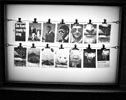|

Comment
on this story
Where:
Frank H. McClung Museum, 1327 Circle Park Drive
When:
Through May 18
|
|

Illuminating the so-called Dark Continent, part 2 (of 2)
by Heather Joyner
Presenting as comprehensive an array of works as the just-closed Ewing Gallery African Art show, "The World Moves, We Follow" (from a Yoruba phrase recognizing the inevitability of change) should fascinate both new and repeat visitors. Beyond its own impressive scope, the show is part of an even greater whole: UT's Africa Semester.
Thematic divisions of objects in "The World Moves" and their significance to some groups were addressed in the Jan. 9 Metro Pulse, but far more can be said, particularly about contemporary works. In fact, so much can be seen and considered in this show that it's a bit overwhelming.
Africa is one big continent, with countries most Westerners could never find on a map—not to mention a complex panoply of languages, religions, and traditions. Add to that the constant shifting throughout time referred to in the show's title, and it's hard to fathom how materials found in the McClung exhibition can be organized at all. And yet they have been, with sensitivity and insight.
Curator and UT professor Dr. William Dewey remarks that the Yoruba peoples of Nigeria are not unique in their ability to adapt and synthesize. He describes their flexibility as "...under-lin[ing] a philosophical attitude shared by many African cultures, which privileges creative individuals as pace setters in a world where change is embraced as a necessary tonic for rejuvenation." Furthermore, Dewey asserts that the creativity of a range of African cultures "...reveals flashes of the future without subverting the past." That's no easy task, especially when viewed from our perspective. One could argue that art produced in this country has not only dismissed the past, but has stomped on it, as well. The apparent African facility for making something new that, at the same time, acknowledges its historical context reflects an enviable breadth of vision and a sense of continuity within the stream of humanity. And what a magnificent stream it is, if pieces in "The World Moves" are any indication.
The McClung's special exhibition space is somewhat dim (in order to protect artifacts from deterioration), but once one's eyes have adjusted, the low-level lighting lends certain works an appropriate aura of mystery. After all, numerous objects were created for sacred rites with limited participation. For instance, an early 20th-century Chokwe (of Angola/Zambia) divination basket with bountiful carved figures, seeds, shells, and collected items such as a fragment of false teeth and a baby-doll hand is meant to be shaken or tossed to reveal solutions to problems known only to the diviner and his or her clients. The configuration of the basket's contents can determine how a person addresses concerns including illness, death, and infertility. Dewey explains that unlike a fortune teller, a diviner (or nganga) uses the basket and an accompanying rattle to determine a course of action.
Much contemporary African art relates to hybrid religious practices or political attitudes and issues resulting from cultural interaction. Indiana State University art historian dele jegede says, "The dichotomy between traditional and contemporary [art] can be traced to the introduction of Western education in Africa.... In actuality, the continent of Africa has always been in a flux arising from the myriad of influences that it has been exposed to.... Western culture and Islamic mores fuse with traditional African systems of thought to produce a vibrant, pulsating kaleidoscope."
UT's Dr. Rosalind Hackett reiterates that missionary and colonial influences have often meant the incorporation of new theological concepts into existing ones. "A number of artists do not want to be classified as belonging to any particular religion and have instead sought a synthesis of different religious paths," she says. She adds, however, that "the growing presence of Islam can be noted," especially in the realm of the popular arts. Islamic "magic square" patterns found in modern adinkra cloth from Ghana are but one example.
A contemporary Nkisi from the Democratic Republic of the Congo (formerly Zaire) possesses no discernible religious iconography, but it does refer to the spiritual domain. An upright male figure, it has mirror eyes and a square-shaped mirror concealing its contents. According to a placard, "The mirror sealing the container is a metaphor for the nganga's powers to look beneath the shiny surface of the river of the sea into the realm of the spirits and the ancestors." A 20th-century man's robe (or riga) from the Hausa people of Nigeria has an overall shape and indigo color that could be Japanese. Its "wiseman's knots" look Celtic in origin, whereas an embroidered spiral seems distinctly African. Variety abounds.
Along different lines, South African artist Sue Williamson makes powerful political statements with her groupings of text and black and white photography on acetate. "Cold Turkey: Stories of Truth and Reconciliation" (named for a government commission) is comprised of two sets of images hung from metal clips in rows against an illuminated backdrop suggesting a light table in a journalist's office. The set titled "De Kock Ready To Sing" features photos of both a man and a pig. The man is Eugene de Kock (a notoriously cruel police commander), and the pig refers to bombs placed inside pigs' heads and used for murdering human rights advocates. "Poison Victim" has pictures of anti-apartheid activist Sipho Mtimkulu, whose whereabouts after being fed rat poison in prison remain unknown.
Nigerian Jimoh Buraimoh's "Animal," a delightful painting adorned with glass beads adhered to shapes reminiscent of Mir�, and "Amphora II" by Kenyan Magdalene Odundo (one of the simplest, most beautiful ceramic vases imaginable) exemplify the best of what "The World Moves" has to offer in terms of straight contemporary art. Seeing those pieces alongside so many others, I realize I can't think of a better escape from a dreary day.

March 6, 2003 * Vol. 13, No. 10
© 2003 Metro Pulse
|